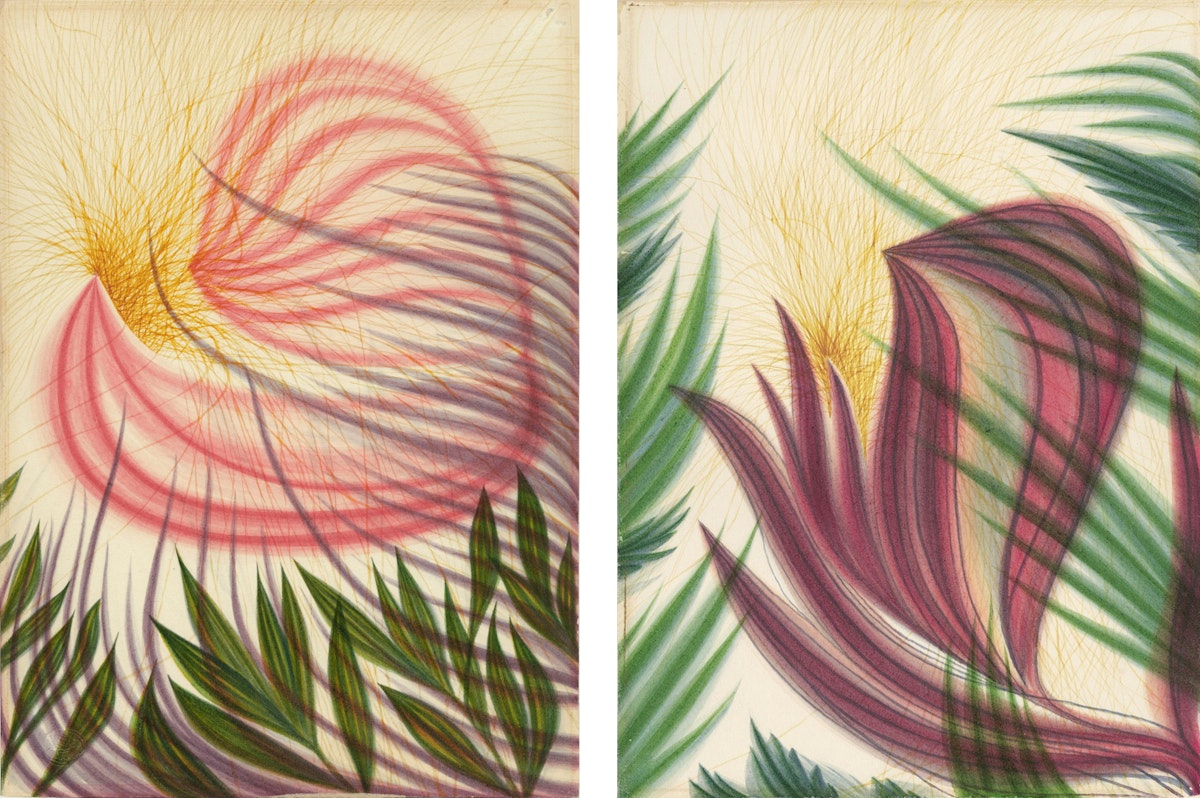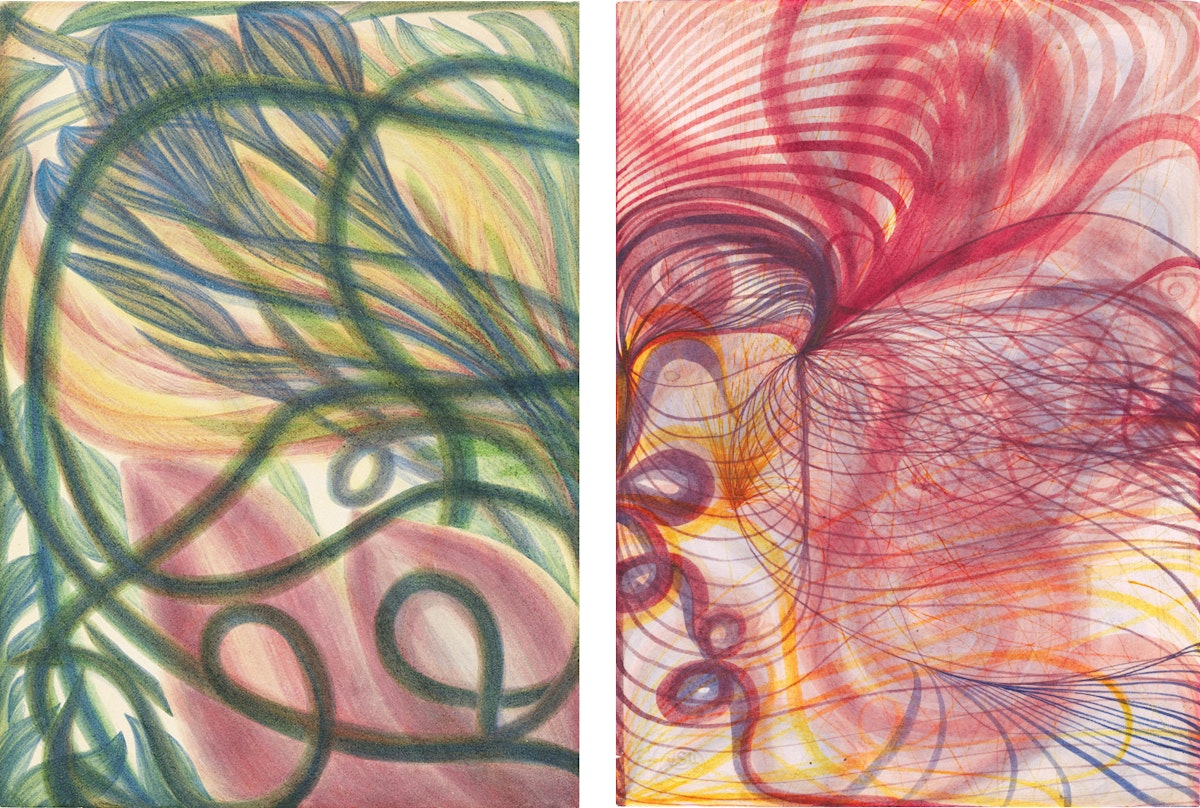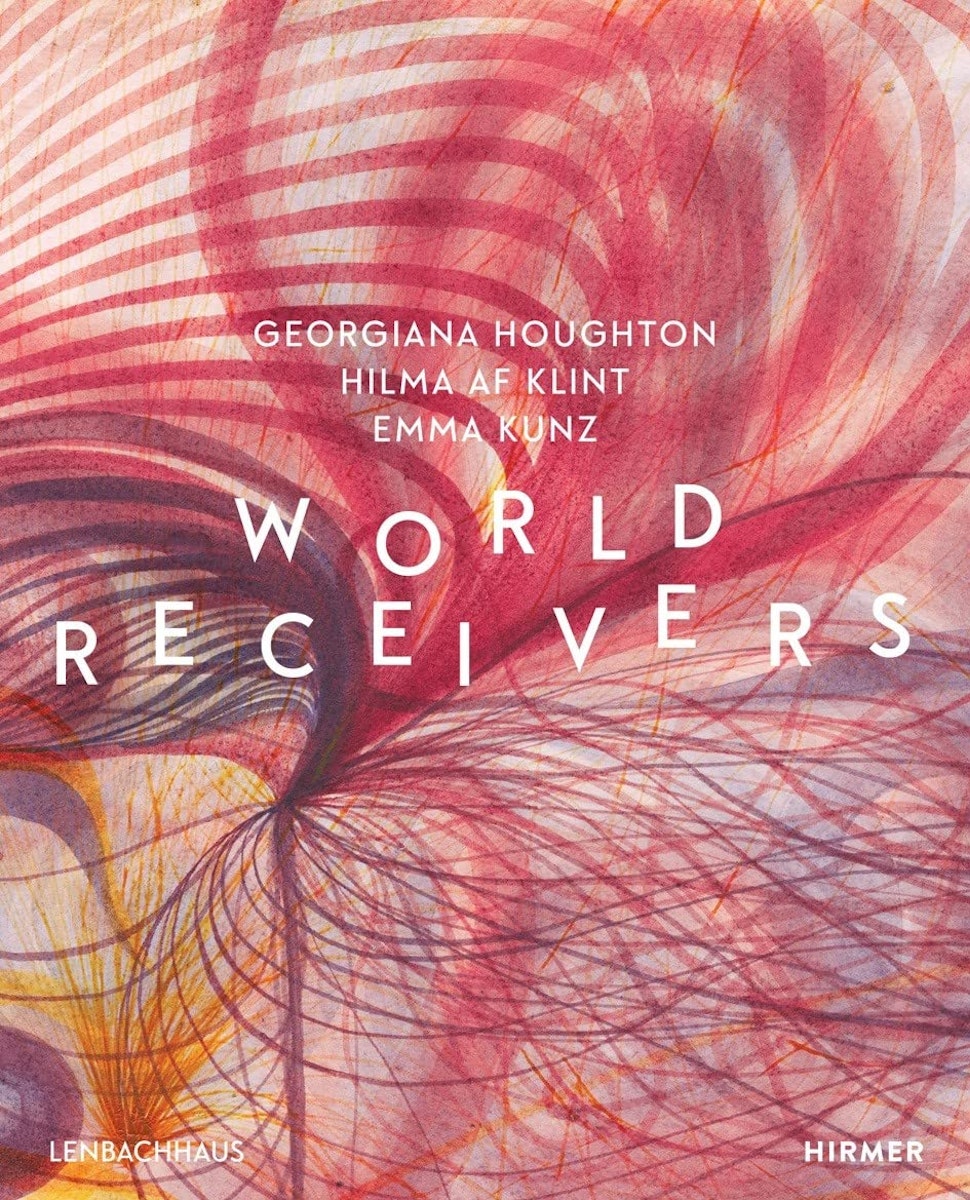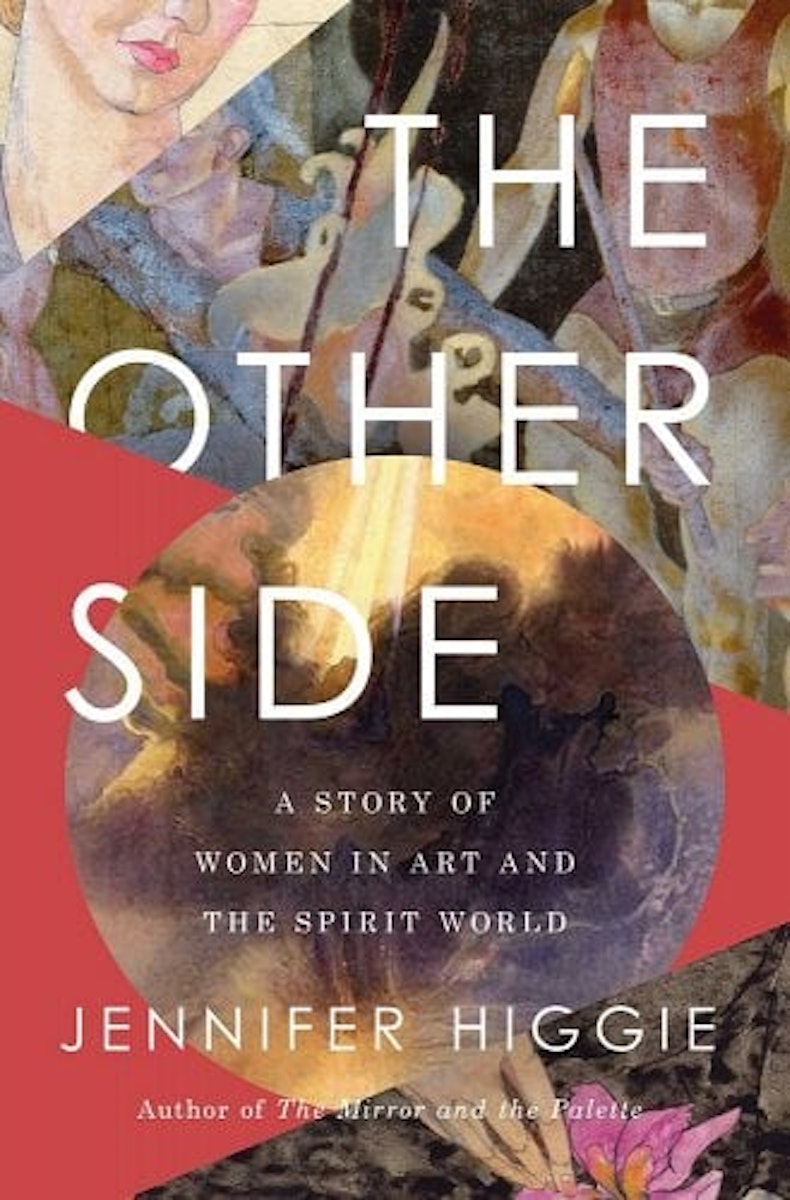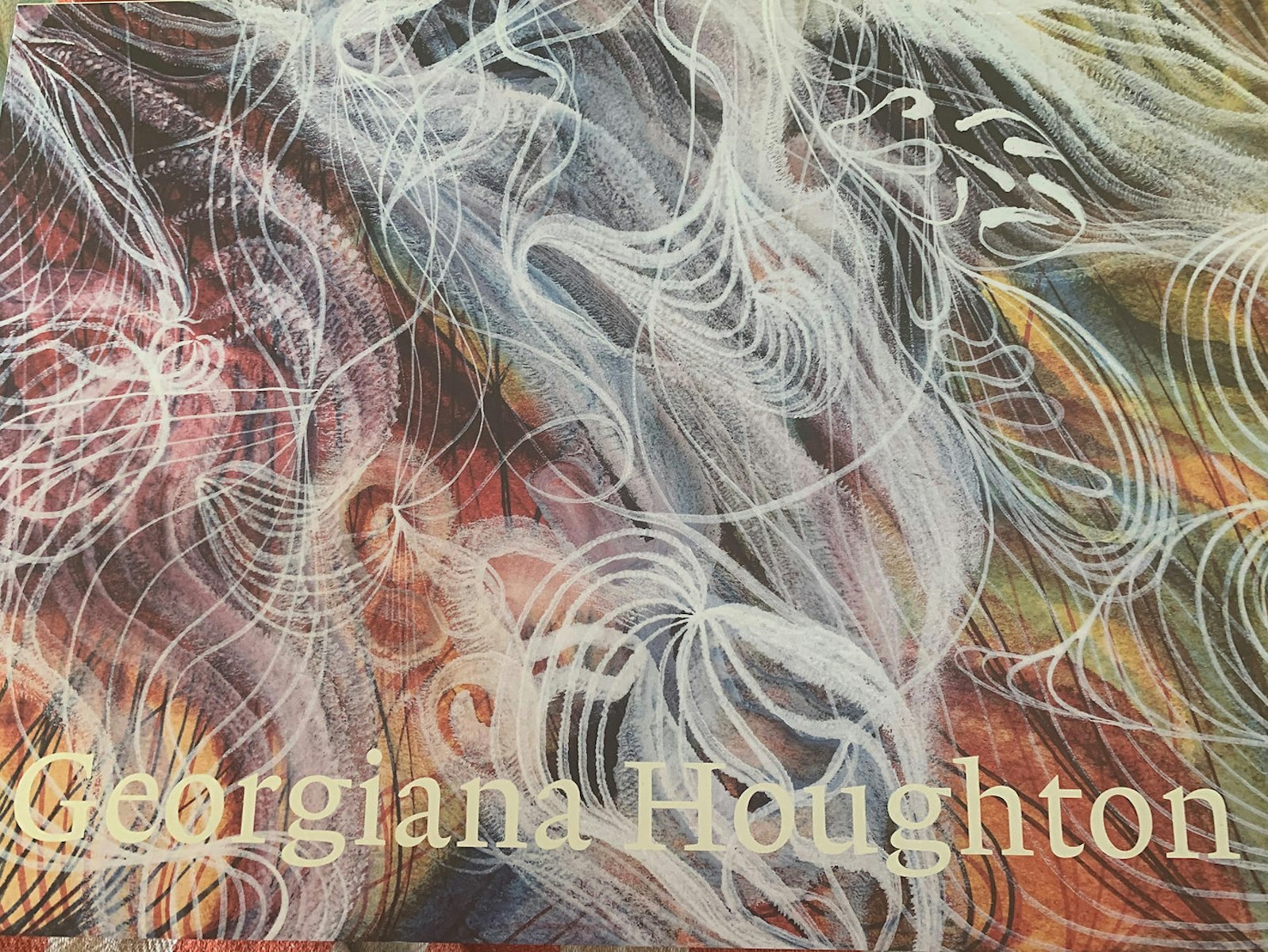
“The Substantiality of Spirit” Georgiana Houghton’s Pictures from the Other Side
When Georgiana Houghton first exhibited her paintings at a London gallery in 1871, their wild eddies of colour and line were unlike anything the public had seen before — nor would see again until the rise of abstract art decades later. But there was little intentionally abstract about these images: Houghton painted entities she met in the spirit regions. Viewing her works through the prism of friendship, loss, and faith, Jennifer Higgie turns overdue attention on an artist neglected by historians, a visionary who believed that death was not the end, merely a new distance to overcome.
February 21, 2024
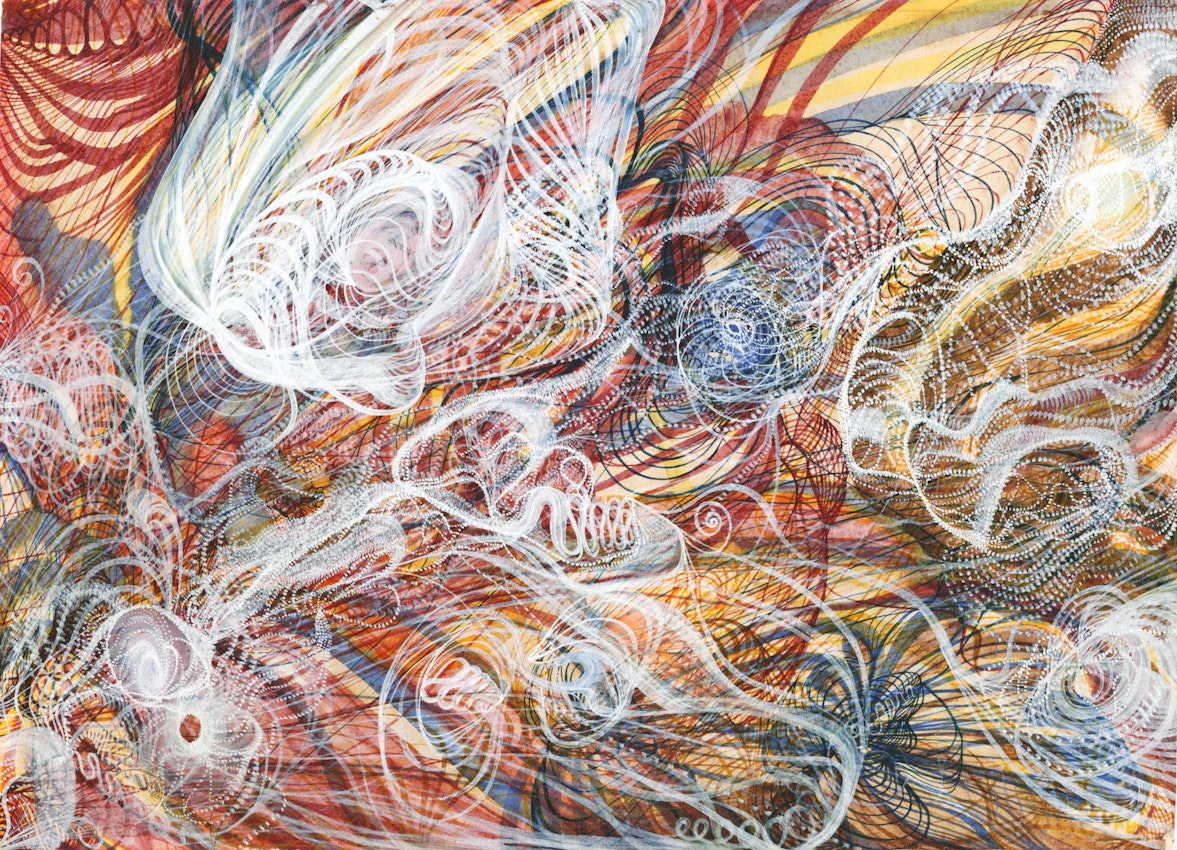 Scroll through the whole page to download all images before printing.
Scroll through the whole page to download all images before printing.Georgiana Houghton, The Risen Lord, 1864 — Source. (Photograph: Victorian Spiritualists’ Union, Melbourne.)
“Everybody is talking about the Spiritual pictures in Old Bond Street. I went there yesterday, and a more surprising collection of 150 paintings I never saw . . . beautiful workmanship, warmness, manual application — and the colouring is a new revelation.”—Unattributed newspaper review of Georgiana Houghton
The details are sketchy. Born to a middle-class family in 1814 in Las Palmas in the Canary Islands, Georgiana was the seventh of twelve children. Her father was a wine and brandy merchant; her mother had her hands full with her enormous brood. The family moved to London when Georgiana was small, but they lost their money. Not much is known about her childhood, apart from the fact that the family experienced genteel poverty. It’s clear, though, that Georgiana suffered great losses: her nine-year-old brother Cecil Angelo died when Georgiana was twelve, her elder brother Warrand when she was twenty-seven, her brother Sidney when she was thirty-one, and her especially beloved younger sister Zilla Rosalia when she was thirty-seven.
I suspect we assume that people in previous centuries — given the higher mortality rates — were more accustomed to death than we are. While that might be true, death is still death. To those left behind, it’s unfathomable to grasp non-existence: grief can be inarticulate. If there was even a glimmer of possibility, who wouldn’t want to try and reach those we love, to know that they were safe and well? Georgiana trained as an artist — it’s not known where — but for some reason she gave it up when Zilla, who was also an artist, died. Georgiana never married. She lived with her family, then her parents, then her mother, and then alone — although the word “alone” in her case is not one she would have agreed with. In 1859, still mourning, at the invitation of her cousin, Mrs Pearson, Georgiana attended a séance held by a neighbour, Mrs Marshall. She was not young and impressionable: she was a middle-class woman of forty-five, but she heard and saw things that day that made her believe in the veracity of supernatural communication. Her experience convinced her that death was not the end; it was more like moving into a different room and talking through a wall.
And so, it began. Spiritualism would consume her until the end of her life.
Georgiana discovered that, with persistence, she could train herself to become a medium. She was a Christian, but Christianity doesn’t preach communication beyond death. She brushed this aside. She began by sitting with her mother at twilight, discussing spiritual matters. After three months, on December 31, 1859, the table tipped and messages from the other side began to flow. So did the pictures.
In 1861, Houghton saw the spirit drawings created by, or through, a Mrs Wilkinson. Impressed, she began producing her own, first by attaching coloured pencils to her planchette — French for “little plank”, a wooden device on two-wheeled casters that holds a pencil.
After a while, on the advice of her spirit guides, she drew freehand and then graduated to painting, combining watercolour, gouache, and ink. In 1863, she began hosting weekly soirées to showcase her pictures. It was around this time that one of her guests, the American Reverend John Murray Spear, admiringly called her the “Holy Symbolist”.
She had the gift of sight, perfect vision, in all realms. Spirits appeared before her as clearly as the artists and archangels who guided her hand. Images poured from her. Even now, 150 years later, the energy and inventiveness of her work leaps off the page. In gouache, pen and ink, it’s as if her dreams are ensnared by a spider web: primary colours whirl and dance beneath a delicate net of white translucent lines. Her pictures pulsate with life and rhythm: they’re at once abstract, representational, full of intense, feverish feeling; exultant, dense, replete with possibility. Colours swirl and eddy; fruit, the faces of Jesus and Houghton’s dead sister Zilla emerge from the maelstrom only to be submerged, once again. She saw flowers as “the essence of a person’s life and character” and they populate her pictures like phantoms. This is art as the expression of life: one in which death is equally vivid, unconstrained, unique. No one was making anything like this in the London art world of the 1860s. No one is making anything like this today.
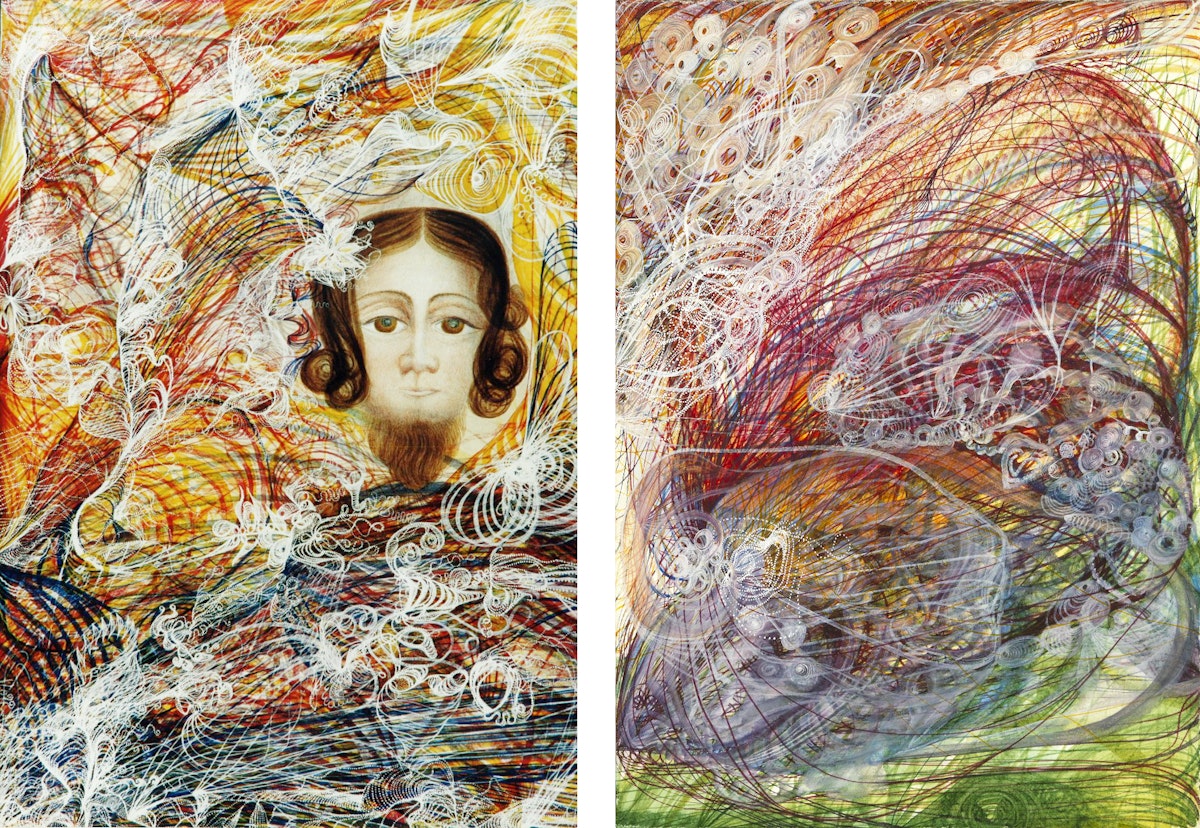 Scroll through the whole page to download all images before printing.
Scroll through the whole page to download all images before printing.Georgiana gave her pictures descriptive titles: Study of Curves, A Little More Design, Still More Design, Cecil’s Fruit, Zilla’s Flower. Some of them are grouped into series of flowers, or the names of friends and family members she contacted via her mediumship; her dead siblings and her first guide Henry Lenny, H.R.H. the late Prince Consort, H.R.H. Victoria, Princess Royal of England, and artists including William Blake, Caravaggio, Correggio, Bartolomé Murillo, Titian, and seventy archangels. Via her guides, she explored subjects such as The Trinity, God, Spirit, Peace, Wisdom, and the Unveiling of the Heavens. Along with self-portraits, she drew some of her fellow mediums and other living people close to her.
She used colours to represent particular states: Yellow for God the Father, Wisdom, and Faith; Chinese Orange for unselfishness and Violet Carmine for religion; Cobalt Blue for truth, Crimson Lake for love, and so on. In 1865, some of her works were accepted by the Royal Academy but they were never displayed. There is no record of why, but it’s not difficult to imagine. Her pictures would have been as startling as a spaceship landing among the horse-drawn carriages of Piccadilly.
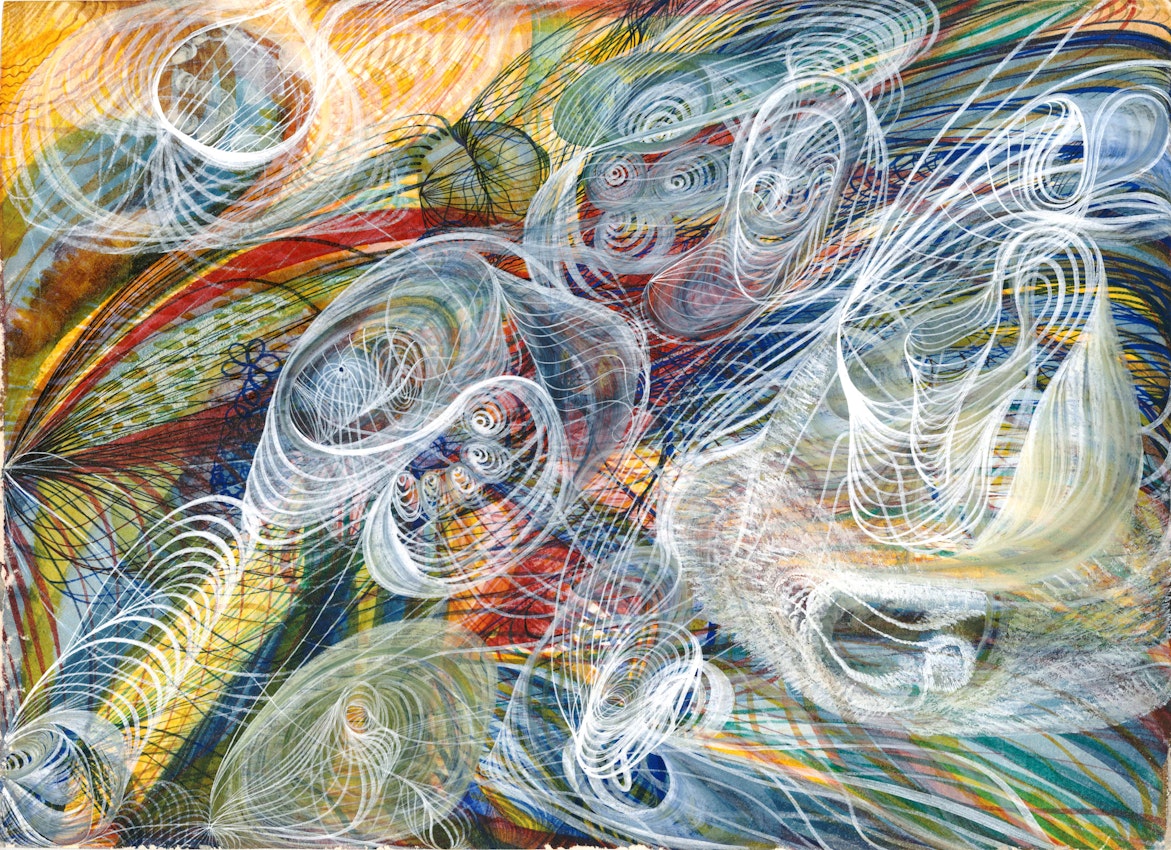 Scroll through the whole page to download all images before printing.
Scroll through the whole page to download all images before printing.Georgiana Houghton, Glory Be to God, 1864 — Source. (Photograph: Victorian Spiritualists’ Union, Melbourne.)
The year 1869 was a terrible one for Georgiana: her mother, younger brother George and her nephew Charlie — Zilla’s son — all died. Charlie eventually became one of her spirit guides. He had drowned and his presence was often heralded with a sensation of damp.
In 1871, Georgiana rented The New British Gallery on 39 Old Bond Street to display 155 of her drawings. Titled “Spirit Drawings in Water Colours”, the catalogue accompanying the exhibition was something of a work of art in itself: its pages were tinted a delicate pink, the colour of “a type of the Love exemplified in all the teaching”; the cover was brown, “to exemplify that it was given through an earthen vessel” and it was partly covered in cloth, “because it was not intended as only an ephemeral production, but one that I trusted might still go on doing a work when the Exhibition had become a thing of the past”. She was not modest about what she — or her spirits — had achieved. She sent bound copies to Queen Victoria, the Crown Prince of Germany, and the Emperor Louis Napoleon. She never heard back from them.
The evolution of her exhibition is as mysterious as the work itself. In 1882, two years before she died, Georgiana published her memoir: Evenings at Home in Spiritual Séance. It’s a gift of a book: it is rare to have such access to the thinking of an artist. She outlines in great detail how the exhibition came about. She is visited by an “artist friend” — a cryptic Mr L — who, impressed by her pictures, asks her: “Why do you not exhibit?’ Georgiana explains that the main reason is that her use of religious symbolism “would be out of place in a heterogeneous collection”, and that her “Royal Monograms had not been admitted by the Academy”. But Mr L does not mean the Academy and encourages her to have an exhibition of her own. The thought initially bewildered Georgiana: how could she achieve something like this, in her “lonely life, a weak woman, with none to help me in an undertaking of such magnitude? The very notion of such a thing seemed an utter incongruity, and I could only point out to him that I should not even have an idea how to take the very first step towards such an attempt, or as to what ought to be the first step.” But Mr L is happy to help with the organisation of the show and when Georgiana appealed to her “counsellors” as to the wisdom of such an undertaking, she was surprised to hear it was to be. Before the exhibition opened, Georgiana sent out a leaflet outlining her intentions:
Miss Houghton has taken the above Gallery for the purpose of exhibiting the collection of Drawings in Water Colours that have been executed through her mediumship during the last ten years, to offer to others, as well as to Spiritualists, an opportunity of seeing the representations of some of those flowers that may meet their eyes when they enter upon a future existence, and likewise to give some insight into spiritual symbolism in an artistic point of view. To those who do not understand the subject, it may be needful to explain that in the execution of the Drawings, she has been entirely guided by invisible spirits, who could thus delineate what was beyond the human imagination.
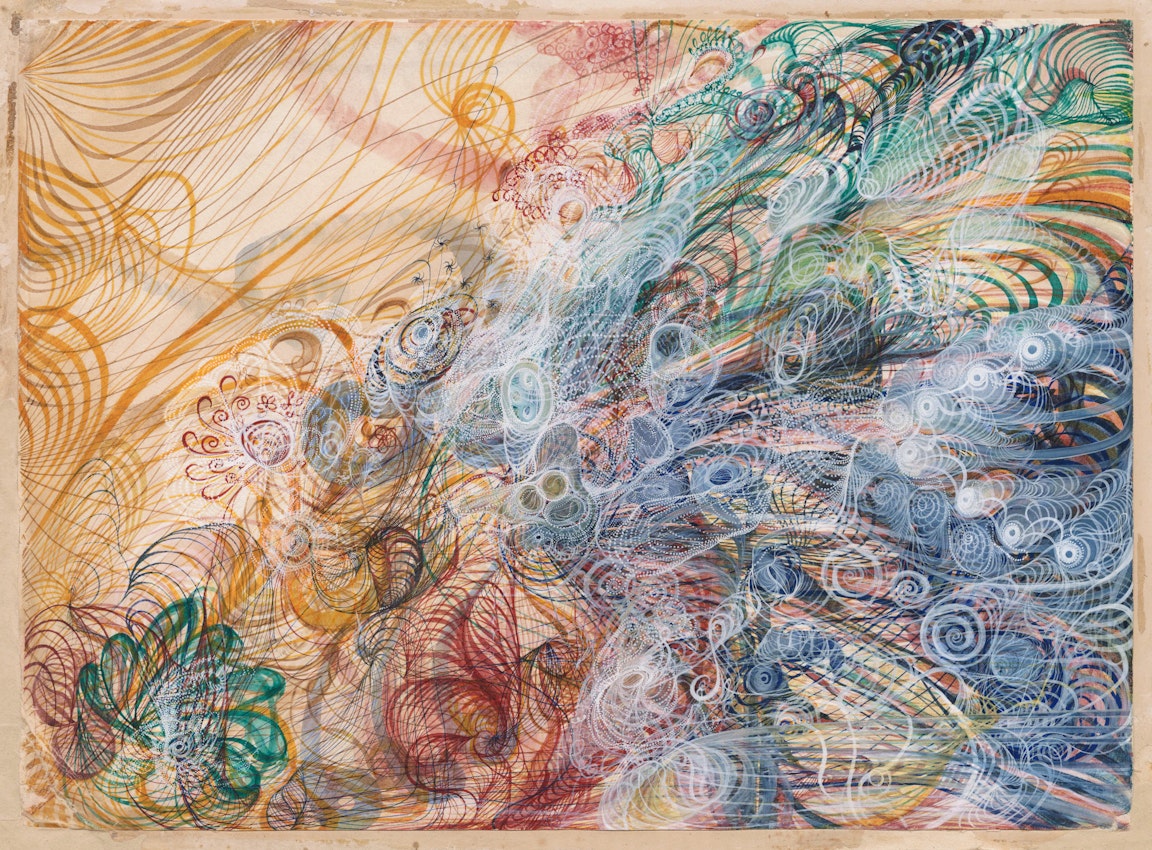 Scroll through the whole page to download all images before printing.
Scroll through the whole page to download all images before printing.Georgiana Houghton, The Glory of the Lord, 1864 — Source. (Photograph: Victorian Spiritualists’ Union, Melbourne.)
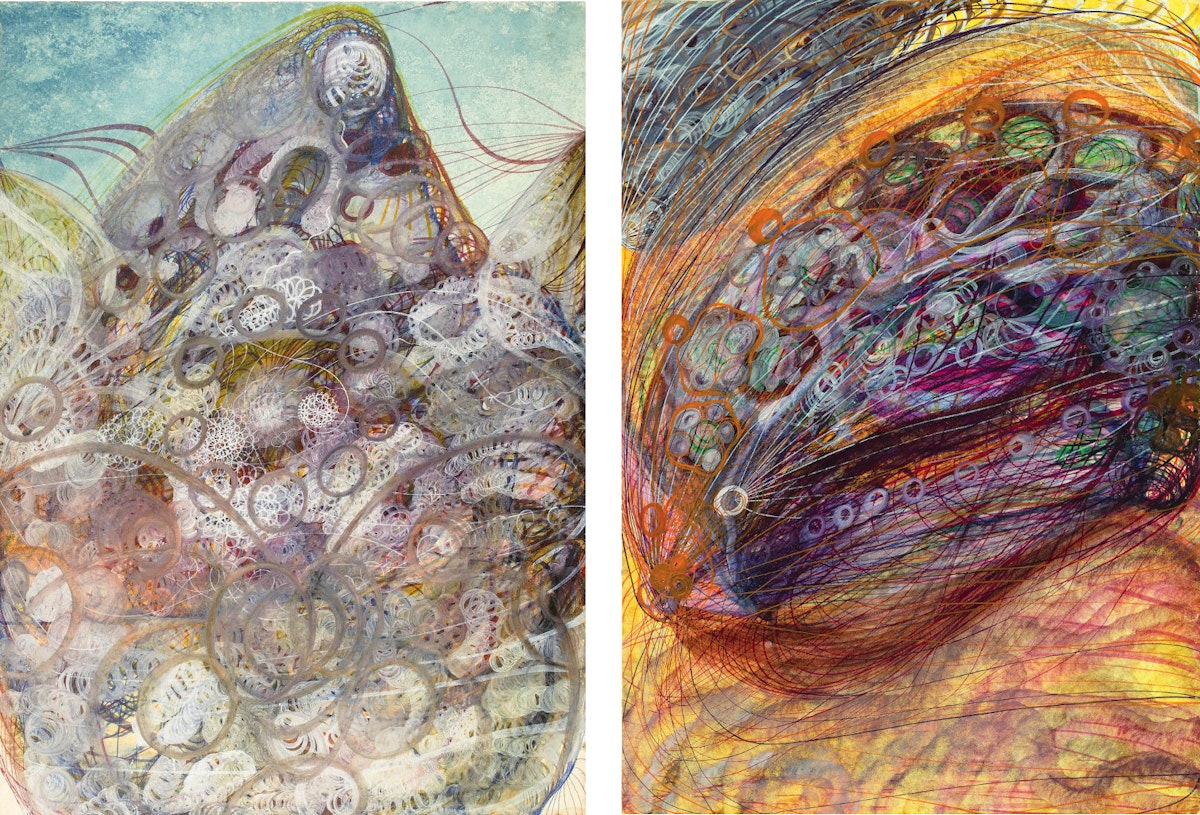 Scroll through the whole page to download all images before printing.
Scroll through the whole page to download all images before printing.Two paintings by Georgiana Houghton: left, The Spiritual Crown of Annie Mary Howitt Watts, 1867; right, The Spiritual Crown of Mrs Oliphant, 1867 — Source: left, right: Jennifer Higgie, The Other Side (Pegasus Books, 2023). (Photographs: Victorian Spiritualists’ Union, Melbourne.)
When the exhibition opened to the public, the baffled art critic for The Era newspaper declared it: “The most astonishing exhibition in London at the present moment.” The critic for The Daily News wrote that the paintings looked like “tangled threads of coloured wool” and concluded: “They deserve to be seen as the most extraordinary and instructive example of artistic aberration.” One writer felt that the pictures were “quite unlike anything that is seen in this world”. The News of the World praised “the brilliancy and harmony of the tints” and asserted that “the idea presents itself to the imagination of a canvas of Turner’s, over which troops of fairies have been meandering, dropping jewels as they went. Miss Houghton, the lady executant, is a clever and tasteful artist; and furthermore, a sincere believer in what she says.”
Other critics weren’t so kind. One journalist fumed that: “We should not have called attention to this exhibition at all, did we not believe that it will disgust all sober people with the follies which it is intended to advance and promote.” But as the sympathetic reviewer for The Queen observed: “The water-colour drawings, numbering one hundred and fifty-five, are so extraordinary in character, and are so entirely opposed to one’s ideas of art, ancient or modern, that criticism in the ordinary manner becomes difficult, not to say impossible.” Georgiana explains that the exhibition was most popular among the clergy, of all denominations, and especially artists, who “revelled in the glories of colour, the marvellous manipulation, the delicacies of delineation”. One of them said to her that “all artists well know . . . that the more entirely they yield themselves to intuition, subduing the self-hood, the more perfect becomes their work.”
Georgiana was trusting enough to believe that an audience would find her work as fascinating as she did — who wouldn’t be amazed by messages formed in colour and line from the other side? Despite everything being for sale, at the advice of Mr L she priced the pictures very high; only two sold and she was almost bankrupted. Just fifty or so of her watercolours are now known to exist: most are in the collection of the Victorian Spiritualists’ Union in Melbourne, and the College of Psychic Studies in London owns seven. Yet, Georgiana was not one to be brought down by something as earthly as commercial failure. In her memoir she recalled: “And about my Gallery! my beloved Exhibition! Heavy as was the loss, never for one moment have I experienced a shadow of regret for having undertaken it.”
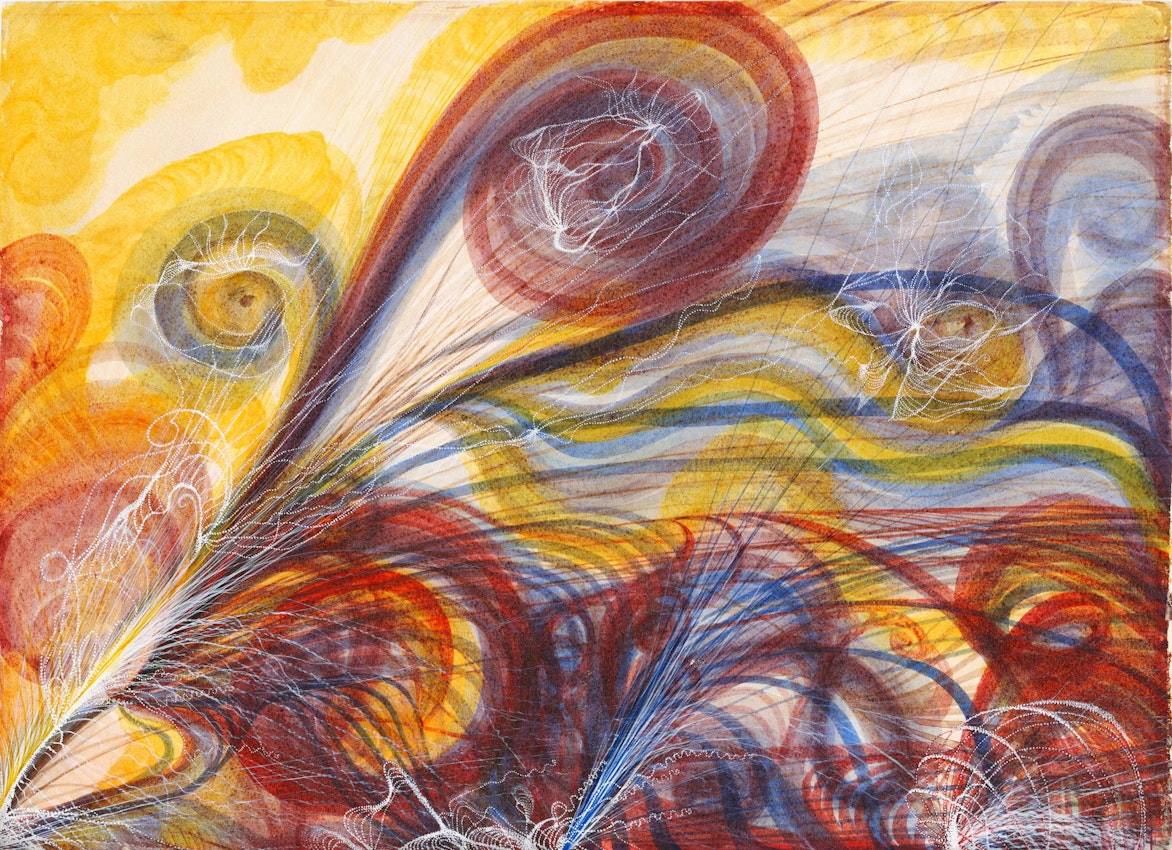 Scroll through the whole page to download all images before printing.
Scroll through the whole page to download all images before printing.Georgiana Houghton, The Eye of God, 1862 — Source. (Photograph: Victorian Spiritualists’ Union, Melbourne.)
Her faith in herself, and her spirit guides, was vindicated in the twenty-first century. When London’s Courtauld Institute of Art staged an exhibition of her work in 2016, it was the first time her pictures had been seen in the United Kingdom since her Bond Street show — and they were astonishing. One critic wrote: “To look at these works, you’d think they were Freudian experiments, made at the height of European Surrealism, or else acid-addled ’60s psychedelia.” Personally speaking, they shifted everything for me. Not only were they wildly, surprisingly fresh, despite being made more than a century ago, but if such radical pictures had been excluded from the art-historical canon, it begged the question: what, and who, else was left out?
Like so many Spiritualists, new technologies transfixed Houghton. In 1859, she had received a message from her archangel guides that “the time was approaching when they would be able to impress their portraits on the photographic plate”. In 1872 she was introduced to the photographer Frederick Hudson, who took her portrait. The result astonished her. She is pictured with an ethereal woman, draped in white sheets: supposedly a ghost. Georgiana’s right hand clings to the left hand of the figure, whose right hand reaches out as if to stroke Houghton’s face. On the back of the photo is an inscription:
My dear sister Zilla, on whose birthday it was taken. . . . Around me, is the light binding us to each other. This is the first manifestation of the inner spiritual life. G. Houghton.
In 1882, she published a book: Chronicles of the Photographs of Spiritual Beings and Phenomena Invisible to the Material Eye. In the preface, she writes: “I send them forth in full assurance that they carry a weight of evidence as to the substantiality of spirit being for transcending any other form of mediumship.”
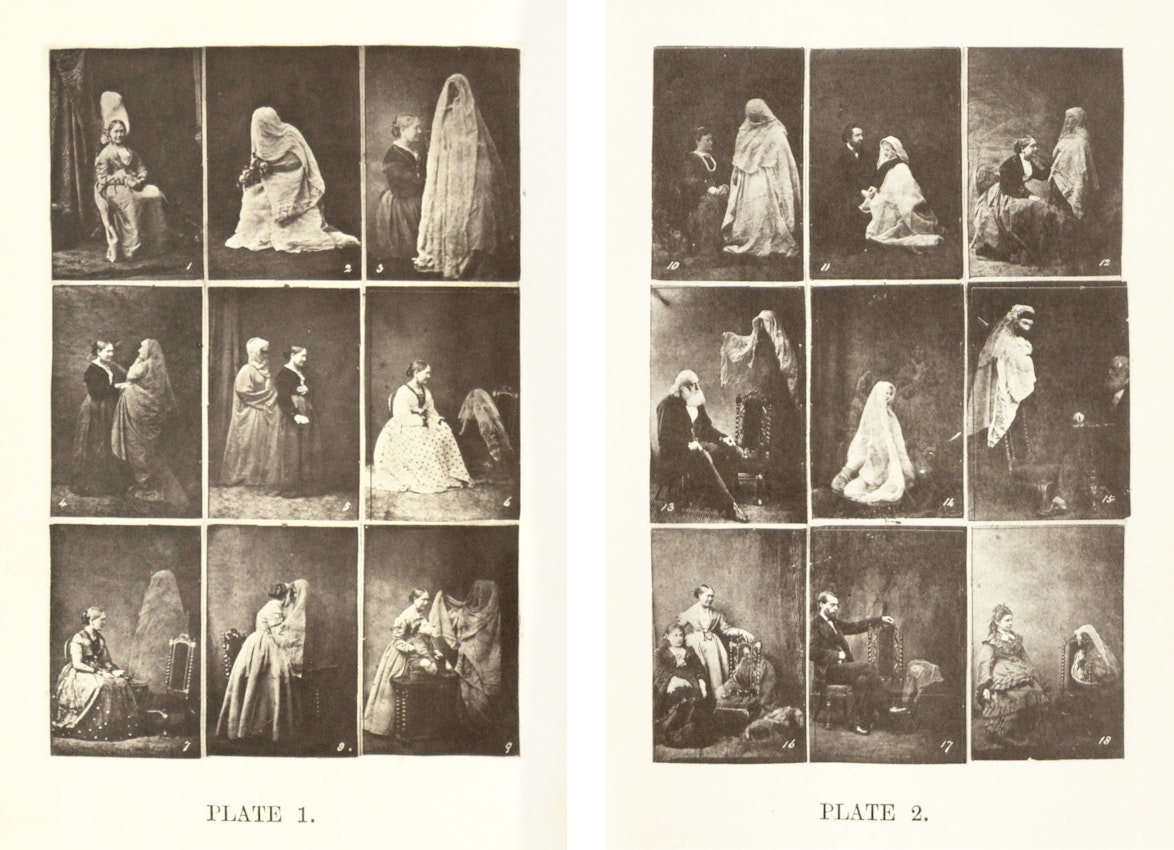 Scroll through the whole page to download all images before printing.
Scroll through the whole page to download all images before printing.Plates of spirit photographs from Georgiana Houghton’s Chronicles of the Photographs of Spiritual Beings and Phenomena Invisible to the Material Eye (1882), many featuring the author herself. The photograph on Plate 1 in the second row and first column is captioned “Zilla Standing, with her hand in mine” — Source.
The book was reviewed by no less a figure than Madame Blavatsky, who declared it “a neat and curious volume” full of “valuable testimony” from “some of the most eminent men of science and literature of the day, who all testify to the fact that photographs have been, and are, taken from ‘Spirit Beings’, their more or less shadowy forms appearing on the negative near or about the sitters in visible flesh and blood.” However, you can sense her scepticism: why, she wonders, the repetition of hazy rigid forms in white sheets? And why is there “such a servile copy of the conventional ghosts in theatricals?”
In her memoir, Houghton, who never questions the veracity of the spirit hand in any aspect of her life, describes photography as full of “fresh marvels”, and explains that her fascination with it is keeping her from her easel. When she poses for Mr Hudson, she is directed by the spirits: the result is something of a human/ghost collaboration. She describes being reunited with her dead nephew Charlie, via the camera lens: “My face is pressed against the spirit, whose veil falls partly over me, so that I am within it, and we seem locked in mutual embrace. The feeling that comes upon me when I look at it, is as if a loved relative whom I thought was dead, had suddenly appeared before me, upon whose breast I would fain weep out of my joy at so unexpected a return.”
There were so many frauds in the spirit world. Science was required to keep it respectable, and a camera was considered more objective than a pencil. Yet many of the spirit photographs look so staged it’s astonishing anyone believed them. But when photography was so new, how were the uninitiated to know how simple it is to create a double exposure?
Even the inventor of the arch-sleuth, Sherlock Holmes, was deceived. A fervent defender of spirit photography, Sir Arthur Conan Doyle, who, in 1893, joined the British Society for Psychical Research (whose members included the future Prime Minister, Arthur Balfour), mentions Georgiana in his history of Spiritualism. He writes: “Hudson, who obtained the first spirit photograph in England of which we have objective evidence, is said to have been about sixty years of age. The sitter was Miss Georgiana Houghton, who has fully described the incident.”
Seen from this great distance, Georgiana Houghton’s work — freely expressive, vividly original, strange — anticipates some of the radical art movements that were to shine so brightly in the twentieth century, such as Surrealism and Abstract Expressionism. But it’s important to remember, as Simon Grant, one of the three curators of her exhibition at the Courtauld Gallery, writes: “While to our eyes these works possess elements of abstraction (a word that did not exist in the context of art in Houghton’s day), to the artist the Spirit Flowers and Spirit Fruits were representations of real objects growing in spirit regions, with each series becoming visually more complex as her own spirit became ‘less clogged with earthliness’”.
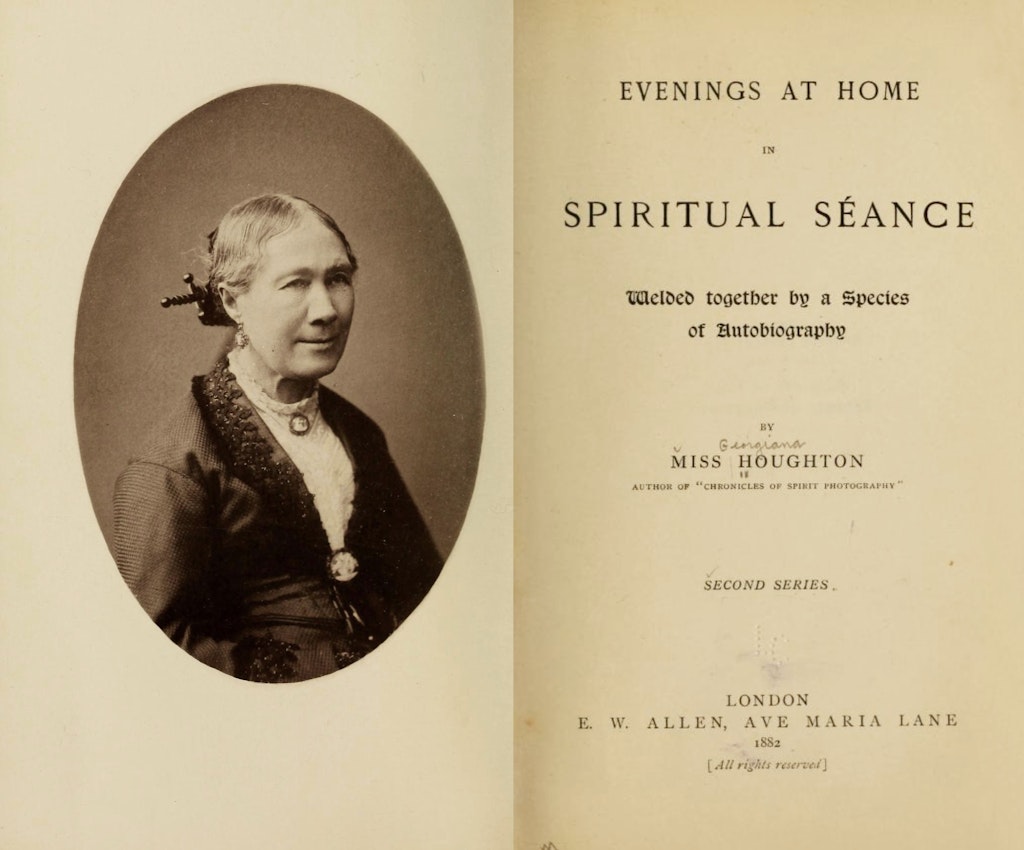 Scroll through the whole page to download all images before printing.
Scroll through the whole page to download all images before printing.Frontispiece and title page of Georgiana Houghton’s Evenings at Home in Spiritual Séance (1882) — Source.
In Evenings at Home in Spiritual Séance Georgiana is open about what transpired at séances. She explains how the immense labour involved in each drawing “would baffle any merely human artist to produce such harmonies” and describes, in a wonderfully matter-of-fact way, the most extraordinary sequence of events: visitations from angels, her dead mother, brothers, the drowned nephew, dripping with water, a General Ramsay and a Native American, a “fair young girl” named Môtee holding a harp. In one memorable experience, floating words illuminate the dark: “Cast thy burthen upon The Lord, and He will sustain thee: His arm will uphold thee, so that the deep waters shall not cover thee.”
In another entry, a spirit writes an 800-word “instructive message” in eight seconds. Georgiana sees white and purple grapes shining in the ether, spirit lights glowing like stars, a crown hovering in the air, and a figure in a blue coat with metal buttons and a thin gold diamond ring; she feels “that upon the table there was a mass of something, wet with rain” and hears “the clatter of cups and saucers”, a “rustling of leaves”, the “fluttering of a bird’s wings” and “a perfect rainbow of sound”. She, and others, are “tenderly touched by the loving fingers of those so dear to us”. She is kissed, given a white coat by Gabriel, and showered with flowers. A pile of “snow-covered ice” is discovered on the table and a wreath placed upon her head. She sees a number of Native Americans with white cloths around them; she is sprinkled with “delicious perfume”, given a ruby, a shell, wet with sea water, and a cup of tea. At times, the table rocks so hard she fears it will be broken. She describes dying as withdrawing “from the earth-plane to enter upon the realities of the world beyond”. She understands table tipping as “a sign that our invisible friends had united with us”. She is dismissive of sceptics, writing: “It also often amuses me when people say that it is ‘contrary to the laws of gravitation’ when a table is raised in the air without visible contact, but they do not imagine that they break a law when they lift up a light table with their own hands, and yet that is an exercise of a precisely similar power.”
It is impossible to know precisely what motivated Georgiana to seek a world beyond her own. Loss, love, the truth? A grief for her family so deep that she conjured them from the air? I do understand, though, that the way art is created is mysterious. It can be as much the product of a dark room as a bright studio.
Jennifer Higgie is an Australian writer who lives in London. Previously the editor of frieze magazine, she has written and illustrated a children’s book, There’s Not One, is the author of the novel Bedlam, and is the author of The Mirror and the Palette: Rebellion, Revolution and Resilience — Five Hundred Years of Women’s Self Portraits.
This essay has been excerpted and adapted from Jennifer Higgie, The Other Side: A Story of Women in Art and the Spirit World (New York: Pegasus Books, 2023). Copyright © Jennifer Higgie 2023.





